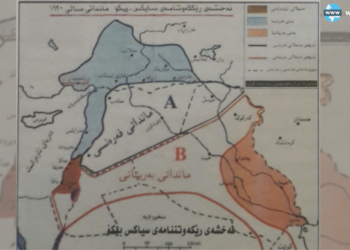First, to understand the Treaty of Lausanne, we must understand the Treaty of Sevres and know briefly what the history before Lausanne was.
The Treaty of Sevres was truly a peace treaty between Italy, Japan, the Ottoman Empire, Germany, Austria, Hungary, Bulgaria, France, Russia, the United States, and Britain, etc. It was signed at the end of World War I on August 10 1920. This was the result of the defeat of the countries, especially the Ottoman Empire, that were at war against the Allies, which later led to the “Modrosi” ceasefire. Armistice of Mudros on October 30, 1918 in Modrosi between Admiral Caltrop, the British envoy on behalf of the Allies, and Raouf Orba, the Ottoman envoy on the Greek island of Limnos, aboard the HMS Agamemnon It was sealed.
This ceasefire intended the complete defeat of the Ottomans and their surrender, which consisted of 24 articles. In general, in World War I, which lasted from 1914 to 1918, the majority and dominant Allies won and the German, Ottoman, Austrian and Hungarian empires collapsed. Later, new states emerged in Europe and West Asia. The 1917 revolution also took place against the Tsarist government of Russia, which became the Soviet Union. That included the February Revolution of 1917, the bipolar revolution of the Workers’ Council and the Social Democratic Provisional State of 1917, followed by the Great October Revolution and the Russian Civil War of 1917-1. It was continue to 6 years and 3 months. The United Nations was established in July 1920 and the end of World War I was declared. After this war and the defeat of the Ottomans, most of the territories of the Ottoman Empire came under the rule of Britain and France. More than 18 million people were killed in the war from 1914 to 1918.
The cause of World War II from 1939 to 1945
The political situation in Germany during the rise of Hitler and the Nazis, Japanese threats against China that led to the Second Japanese-Chinese War, the occupation of Ethiopia by the Italian army that led to the Second Italian-Ethiopian War and territorial control of Eastern Europe. The German invasion of Poland on September 1, 1939, and the consequences of the Treaty of Warsaw (between Germany, Britain, the United States, France, Italy and Japan) in 1919, which came into force in 1920. The Weimar Republic or the German Republic was against the agreement and the provisions of the Treaty of Warsaw. Overall, after the German invasion of Poland, World War II began which lasted from 1939 to 1945 and killed more than 70 million soldiers and civilians. It was generally a discussion of the events of World Wars I and II, but let’s see what the Treaty of Sevres is and what it is about. Can the Treaty of Sevres legally invalidate the Treaty of Lausanne? Or can the Treaty of Sevres be enforced?
Before the Treaty of Sevres on August 10, 1920, Britain and France secretly signed a treaty called the Treaty of Sykes-Picot, which was signed by two high-ranking British and French officers and diplomats, Sir Tatun Mark Sykes and Francois-Marie Denis Picot. The condition of the treaty was the defeat of the Ottoman Empire in war and the division of Ottoman territory among themselves by agreeing Russia in 1916. On this basis, the Arab regions were supposed to be under British and French control. Southern Israel, Palestine, Jordan, southern Iraq, and parts of Haifa and Acre were also given to the British for access to the Mediterranean. In return, north, south, west Kurdistan, Syria and Lebanon should be given to France.
What was the Treaty of Lausanne?
After the Treaty of Sevres, the fascist Turks led by Kemal Ataturk began to oppose it. The Kemalists find a way to abort the Treaty of Sevres, consequently during the meeting of the Turkish National Assembly, Mustafa Kemal Ataturk turned to the Kurdish representatives, or rather the Kurdish Jashes (those who betrayers their country and help their enemy) and some Turks dressed in Kurdish clothes and considered themselves Kurdish representatives. Among them were Hussein Auni and Hassan Khairi, who declared that Turkey is a Kurdish and Turkish country and they do not want to separate and are brothers. They also say that no country can interfere in our will.
Earlier, Ataturk had begun to organize the Turks when the Treaty of Sevres was signed. On September 9, 1919, he held the Sivas Congress and issued a decree saying that the Turkish nation was one and should not be divided. Therefore, in October 1919, at the Amasya Congress, Ataturk defeated his opponents and ended the government of Istanbul. After the Sivas Congress in 1920, Turkey distributed a statement to the ambassadors of Britain, France, the United States, Italy, Serbia, Sweden, Denmark and Spain, stating that the Turkish government did not accept the Treaty of Sevres. After the decision, the Soviet Union will be the first state to sign and recognize the agreement with the Turkish government. Therefore, Britain withdrew from the Sevres Treaty, especially for fear of losing its interests and Soviet hegemony. On February 20, 1921, he announced in London that he was ready to make fundamental changes to the Treaty of Sevres. France has said it is ready to review the treaty, while Italy said it is not ready to use military force against Turkey to implement the Treaty of Sevres, as long as Britain and France want to change it. On the other hand, the Arabs have claimed that they have been oppressed and are opposed to all Kurds, calling them tribes and saying that they cannot establish a state on Arab territory! Thus, the groundwork for the Treaty of Lausanne was paved. Therefore, on August 24, 1923, the Lausanne Treaty was signed and Kurdish was not mentioned in a word. Turkey abandoned Mosul and demanded that the fate of the province be determined by the UN Security Council. Thus, most of Ottoman Kurdistan fell to Turkey, part to Syria, and part to the new Iraq.
Therefore, the Treaty of Lausanne is not legally valid under international law, treaty law and UN human rights law. How 10 countries haven’t signed yet which isn’t even half the sum of one. Hence, 18 countries have ratified and signed the Sever Treaty, but it has not been implemented legally and politically. Thus, the Treaty remains valid and is the Turkish Civil War from 1919 to 1923. Consequently the outcome of the two agreements is completely different. The Sever was to dissolve the Ottoman Empire, determine the fate of the peoples under Ottoman rule and create new states, but Lausanne was only about creating a new Turkish state?!



























































